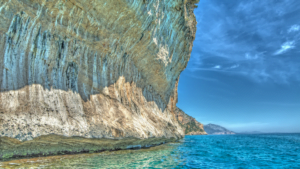Sardinia, the second-largest island in the Mediterranean Sea, boasts some of the most beautiful beaches in Europe, crystal-clear turquoise waters, and rugged coastlines dotted with charming coves and bays. Beyond its breathtaking natural beauty, Sardinia is home to ancient ruins, unique nuraghes (Bronze Age stone structures), and picturesque villages that offer a glimpse into the island’s past.
Top Attractions and Activities
Beaches
La Pelosa

- Overview: Located near Stintino in the northwest, La Pelosa Beach is renowned for its shallow, crystal-clear waters and fine white sand, making it resemble a tropical paradise.
- Highlights: The beach is ideal for families due to its calm waters. A historic watchtower, Torre della Pelosa, adds to the scenic beauty and provides a glimpse into the island’s past.
Costa Smeralda


- Overview: Known for its stunning turquoise waters and pristine white sand beaches, Costa Smeralda is one of the most famous and luxurious beach destinations in Sardinia. It stretches over 20 kilometers along the northeast coast and includes exclusive resorts, high-end restaurants, and a vibrant nightlife.
- Highlights: Popular beaches in this area include Liscia Ruja, Capriccioli, and Spiaggia del Principe. The area is also famous for the Porto Cervo marina, a hub for luxury yachts.
Cala Goloritzé


- Overview: Situated on the eastern coast, Cala Goloritzé is a UNESCO-protected beach famous for its dramatic limestone cliffs, azure waters, and unique rock formations, including the iconic pinnacle known as Aguglia.
- Highlights: Access to the beach is by foot or boat, with a challenging but rewarding hike starting from the Golgo Plateau. The beach is perfect for snorkeling and rock climbing.
Historical Sites
Nuraghes


- Overview: Nuraghes are ancient megalithic edifices found throughout Sardinia, dating back to the Bronze Age. These structures are unique to the island and symbolize its rich prehistoric culture.
- Highlights: The Nuraghe Su Nuraxi in Barumini is the most famous and well-preserved nuraghe, recognized as a UNESCO World Heritage Site. Other notable nuraghes include Nuraghe Losa and Nuraghe Santu Antine.
Archaeological Sites


- Overview: Sardinia is dotted with archaeological sites that offer insights into its ancient civilizations, from the Nuragic era to Roman times.
- Highlights: Tharros, near Oristano, is an ancient Phoenician and Roman city with impressive ruins. Nora, near Pula, features well-preserved Roman mosaics, an amphitheater, and baths.
Traditional Cities and Villages
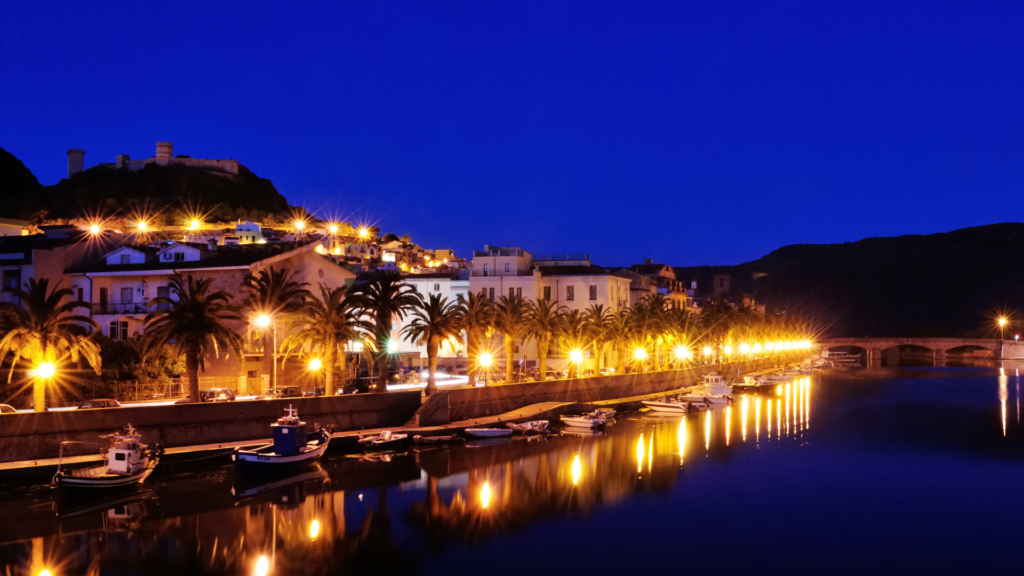

- Overview: Exploring traditional Sardinian villages provides a glimpse into the island’s culture and history, characterized by narrow streets, stone houses, and local crafts.
- Highlights: Villages like Bosa, with its colorful houses along the Temo River, and Orgosolo, famous for its politically charged murals, are must-visit destinations. The village of Mamoiada is known for its traditional masks and the Mamuthones carnival.
Outdoor Activities
Hiking


- Overview: Sardinia offers diverse hiking opportunities, from coastal trails to mountainous paths, suitable for all levels of hikers.
- Highlights: The Selvaggio Blu trail, considered one of the toughest in Italy, spans the rugged coastline of the Gulf of Orosei. For a more leisurely hike, the Su Gorropu Gorge, one of Europe’s deepest canyons, provides stunning scenery.
Biking
- Overview: Biking is a popular way to explore Sardinia’s varied landscapes, from coastal routes to inland trails.
- Highlights: The Alghero to Bosa route offers breathtaking views of the coastline, while the Marmilla region is known for its rolling hills and nuraghe ruins. The Gallura region provides challenging terrain for mountain biking enthusiasts.
Water Sports


- Overview: Sardinia’s clear waters and diverse marine life make it an ideal destination for water sports.
- Highlights: Scuba diving and snorkeling are popular around the La Maddalena Archipelago and Tavolara Marine Reserve. Windsurfing and kitesurfing enthusiasts flock to Porto Pollo and Punta Trettu. Sailing and kayaking are also excellent ways to explore the coastline and hidden coves.
Getting There
Main Airports in Sardinia


Sardinia is well connected by air, with three main airports serving different regions of the island:
- Olbia Costa Smeralda Airport (OLB)
- Located in the northeast, Olbia Costa Smeralda Airport is the primary gateway for travelers heading to the luxurious Costa Smeralda, the La Maddalena Archipelago, and the eastern coast of Sardinia. It is well-connected with numerous European destinations and offers seasonal flights from various cities.
- Cagliari Elmas Airport (CAG)
- Located near the island’s capital in the south, Cagliari Elmas Airport serves as the main entry point for visitors heading to southern Sardinia, including the provinces of Oristano, Sulcis, and Medio Campidano. It offers a wide range of flights from major European cities and other Italian regions.
- Alghero-Fertilia Airport (AHO)
- Situated in the northwest near the city of Alghero, this airport is convenient for those exploring the western and northwestern parts of the island, including attractions like Bosa, Stintino, and the Grotte di Nettuno. Alghero Airport has several international and domestic connections.
Ferry Options from Mainland Italy and Other Countries
Ferry services provide an excellent alternative for reaching Sardinia, especially if you plan to bring a car. Here are the main ferry routes:
- From Mainland Italy:
- Genoa to Olbia/Porto Torres: Multiple daily crossings are available, with an average travel time of 10-12 hours.
- Livorno to Olbia: This route is popular for its shorter duration, approximately 6-8 hours.
- Civitavecchia to Olbia/Porto Torres/Arbatax: Convenient for travelers from Rome, with travel times ranging from 5-10 hours depending on the destination port.
- Naples to Cagliari: Ideal for reaching southern Sardinia, with overnight services taking around 13 hours.
- From Other Countries:
- France (Marseille): Ferries from Marseille to Porto Torres provide a direct route from France, taking about 17 hours.
- Spain (Barcelona): Direct ferries from Barcelona to Porto Torres, with an approximate travel time of 12 hours.
Accommodation Options
Types of Accommodations
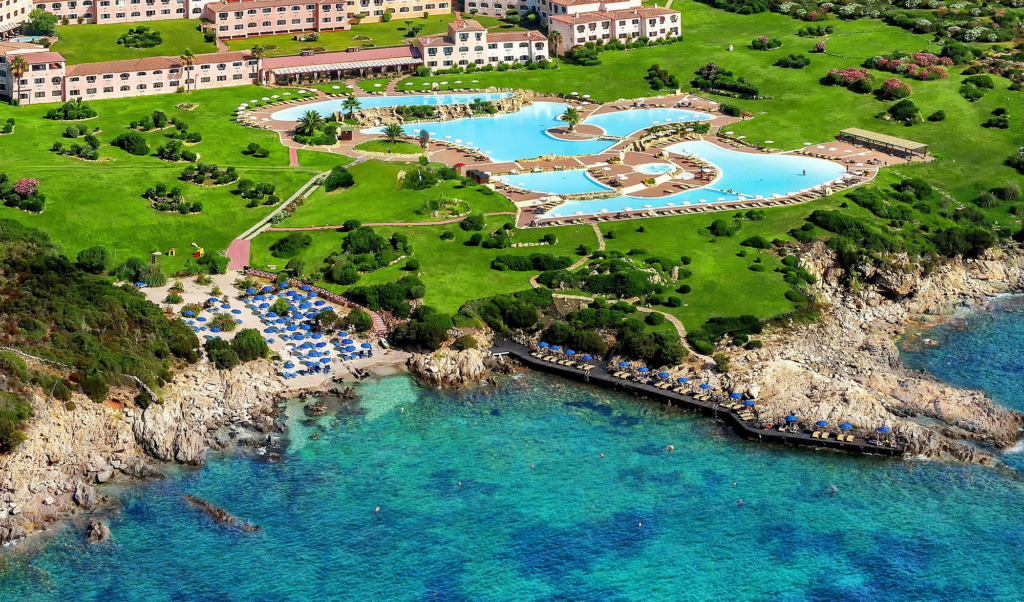

- Luxury Villas
- Overview: Sardinia offers a range of luxurious villas, often situated along the stunning coastlines with private pools, gardens, and panoramic sea views.
- Ideal for: Families, groups, or anyone seeking privacy and upscale amenities.
- Examples: Costa Smeralda is famous for its high-end villas, providing a perfect blend of comfort and exclusivity.
- Eco-Resorts
- Overview: Eco-resorts focus on sustainability and environmental preservation while offering comfortable accommodations. These resorts often integrate local materials and eco-friendly practices.
- Ideal for: Environmentally conscious travelers who wish to minimize their ecological footprint.
- Examples: Resorts in areas like Ogliastra and Costa Verde are known for their eco-friendly practices and natural settings.
- Budget Hotels
- Overview: Budget hotels provide basic yet comfortable lodging at an affordable price. They are often centrally located, making them convenient for exploring urban areas.
- Ideal for: Travelers on a tight budget, solo travelers, or backpackers.
- Examples: Cities like Cagliari, Alghero, and Olbia have a wide range of budget hotels suitable for short stays.
- Agriturismos
- Overview: Agriturismos are farm stays that offer a unique blend of rural charm and local hospitality. Guests can enjoy home-cooked meals, often made from ingredients produced on-site.
- Ideal for: Those looking to experience Sardinia’s countryside, local culture, and traditional cuisine.
- Examples: Popular in regions like Barbagia and the countryside near Oristano.
Best Areas to Stay Based on Activities and Interests
Costa Smeralda


- Activities: Luxury shopping, nightlife, yachting, and exclusive beaches.
- Interests: Ideal for travelers seeking a glamorous vacation with high-end amenities and vibrant nightlife.
Cagliari
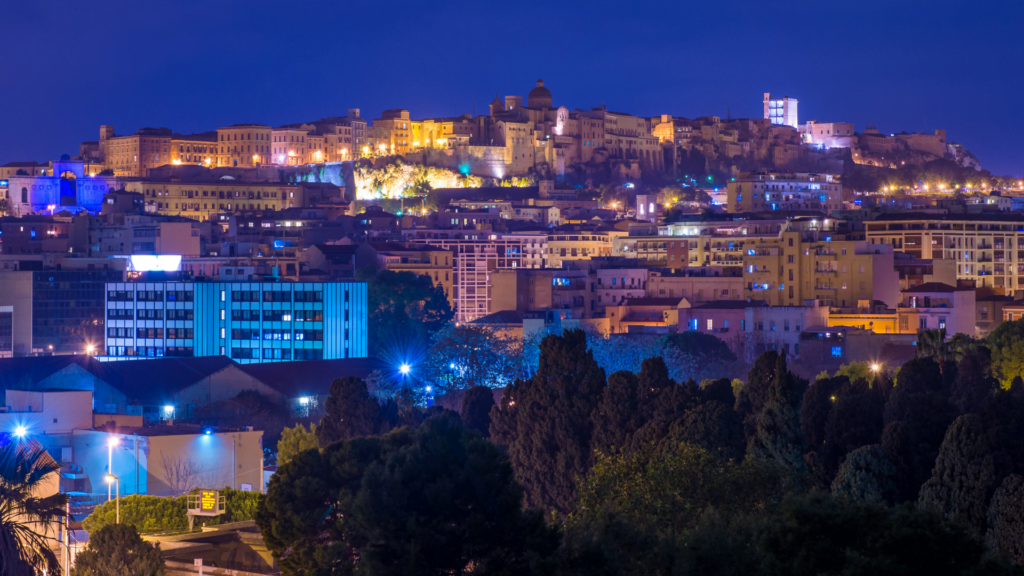

- Activities: Historical sites, museums, shopping, and dining.
- Interests: Perfect for history buffs, urban explorers, and food enthusiasts.
Alghero


- Activities: Exploring historic architecture, beaches, and the Grotte di Nettuno.
- Interests: Great for those interested in a mix of cultural experiences and coastal relaxation.
Ogliastra


- Activities: Hiking, rock climbing, and exploring natural parks.
- Interests: Best suited for adventure seekers and nature lovers.
Oristano


- Activities: Visiting archaeological sites, beaches, and bird watching in the Sinis Peninsula.
- Interests: Ideal for travelers interested in archaeology, wildlife, and quieter beach areas.
Transportation
Renting a Car: Advantages and Tips
Advantages:
- Flexibility and Freedom: Renting a car provides the flexibility to explore Sardinia at your own pace. You can visit remote beaches, hidden villages, and off-the-beaten-path attractions that are not accessible by public transport.
- Convenience: Having a car is convenient for carrying luggage, beach gear, and other belongings without the hassle of public transport limitations.
- Time Efficiency: Renting a car can save time, especially when traveling between different regions or attractions. You won’t have to wait for public transport schedules or deal with multiple transfers.
- Accessibility to Rural Areas: Many of Sardinia’s rural areas and natural parks are best reached by car, as public transport options can be limited or nonexistent.
Public Transport: Trains, Buses, and Ferries
Trains:
- Service: Sardinia’s train network, operated by Trenitalia and ARST, connects major cities and towns, such as Cagliari, Sassari, and Olbia. Trains are generally reliable but may not cover remote or rural areas.
- Usage: Ideal for traveling between larger cities and towns. Train stations are typically located centrally, making it convenient for urban exploration.
Buses:
- Service: Buses are operated by several companies, including ARST and Turmo Travel. They serve both urban and rural areas but can be infrequent and less reliable in remote regions.
- Usage: Buses are suitable for reaching smaller towns and villages not accessible by train. However, schedules can be limited, so plan accordingly.
Ferries:
- Service: Ferries connect Sardinia with mainland Italy and other islands. Companies like Tirrenia, Moby, and Grimaldi Lines operate regular routes.
- Usage: Ferries are ideal for reaching island destinations such as La Maddalena, L’Asinara, and Carloforte. They are also useful for those traveling with a car from the mainland.
Navigating Rural Areas and Small Towns
Road Conditions:
- Quality: Roads in Sardinia range from well-maintained highways to narrow, winding rural roads. Coastal and mountain roads can be particularly challenging, requiring cautious driving.
- Signage: Road signs are generally clear, but in rural areas, they may be less frequent. Having a GPS or a reliable map is essential.
Driving Tips:
- Be Prepared for Wildlife: In rural areas, it’s common to encounter livestock on the roads. Drive slowly and be prepared to stop.
- Fuel Stations: Fuel stations can be sparse in rural areas, so it’s wise to fill up your tank whenever possible.
- Local Etiquette: In small towns, locals may follow different driving customs. Be patient and courteous, especially in narrow streets and during local events.
Parking:
- Availability: Parking in small towns and rural areas is usually easier than in cities. Look for designated parking areas and avoid blocking narrow streets.
- Fees: Some tourist areas may charge for parking, especially near popular attractions and beaches.
Local Culture and Traditions
Traditional Sardinian Cuisine and Dining Tips


Cuisine Highlights:
- Pane Carasau: Also known as “carta da musica” (music paper bread) due to its thin, crisp texture, this traditional flatbread is a staple in Sardinian cuisine. It is often enjoyed with olive oil and salt or used in dishes like pane frattau, where it’s layered with tomato sauce, poached eggs, and pecorino cheese.
- Culurgiones: These are Sardinian stuffed pasta dumplings, similar to ravioli, but filled with a unique mixture of potatoes, pecorino cheese, garlic, and mint. They are often served with a simple tomato sauce or browned butter.
- Porceddu: A traditional dish of suckling pig roasted on a spit, seasoned with myrtle and rosemary. This dish is often prepared for special occasions and festivals, reflecting the island’s pastoral heritage.
- Seadas: A popular dessert made from semolina dough filled with fresh pecorino cheese, deep-fried, and drizzled with honey. The combination of the savory cheese and sweet honey makes it a unique and delicious treat.
- Seafood: Given its island geography, Sardinia boasts a wide variety of fresh seafood. Dishes like bottarga (cured fish roe), fregula (a type of pasta similar to couscous) with clams, and octopus salad are common.
Dining Tips:
- Meal Times: Lunch is the main meal of the day, typically eaten around 1-2 PM, while dinner is usually served late, starting from 8 PM onwards. It’s common for restaurants to close between lunch and dinner.
- Tipping: Tipping is not obligatory in Sardinia, but leaving small change or rounding up the bill is appreciated if you receive good service.
- Local Specialties: When dining out, ask for local specialties and seasonal dishes. Many restaurants pride themselves on serving traditional recipes with local ingredients.
- Agriturismos: Consider dining at an agriturismo (farm stay) to experience authentic Sardinian home-cooked meals made with farm-fresh ingredients. These meals often include multiple courses and offer a true taste of rural Sardinian life.
Festivals and Cultural Events


- Sant’Efisio Festival (Cagliari): Celebrated every year on May 1st, this festival is one of the most important religious events in Sardinia. It features a colorful procession with participants dressed in traditional costumes, riding decorated carts, and paying homage to Saint Efisio.
- Autunno in Barbagia: This event takes place from September to December, showcasing the culture, traditions, and crafts of the Barbagia region. Villages open their doors to visitors, offering local food, wine, and handicrafts, and demonstrating traditional practices.
- Sagra del Redentore (Nuoro): Held in late August, this festival celebrates the Feast of the Redeemer with religious processions, traditional music, dance performances, and folk costumes. It culminates in a pilgrimage to the statue of Christ the Redeemer on Monte Ortobene.
- Cavalcata Sarda (Sassari): This event, held in late May, is a spectacular display of Sardinian horsemanship, traditional costumes, and folk music. It includes parades, horse races, and performances by folk groups from across the island.
Practical Tips
Budgeting for Your Trip
Cost of Food:
- Eating Out: Expect to spend around €15-€30 per person for a meal at a mid-range restaurant. High-end dining can go up to €50 or more per person. Budget travelers can find cheaper meals at pizzerias or cafes, costing around €10-€15.
- Groceries: If you prefer self-catering, groceries can be reasonably priced. Weekly groceries for two people might cost around €50-€150, depending on your choices.
- Local Markets: Shopping at local markets can be a great way to save money and experience Sardinian produce. Prices are generally lower than in supermarkets, and the quality is often higher.
Cost of Accommodation:
- Luxury Villas and Hotels: Prices for luxury accommodations can range from €200 to over €500 per night, especially in popular areas like Costa Smeralda.
- Mid-Range Hotels and Apartments: Expect to pay between €50-€150 per night. This range covers a variety of comfortable and convenient options, from city hotels to rural agriturismos.
- Budget Options: Hostels and budget hotels typically cost between €30-€50 per night. Booking in advance can help secure lower rates, especially during the high season.
Cost of Activities:
- Attractions: Entry fees for museums and archaeological sites usually range from €5-€15. Some attractions, like beaches and hiking trails, are free.
- Tours and Excursions: Organized tours, such as boat trips or guided hikes, can cost between €30-€100 per person, depending on the duration and type of activity.
- Transport: Car rentals can cost around €30-€70 per day. Public transport is cheaper but less flexible, with bus tickets costing around €1.50-€3.50 per trip.
Health and Safety Tips
- Healthcare: Sardinia has a good healthcare system with hospitals and clinics in major towns. For minor ailments, pharmacies are widely available and pharmacists can offer advice and medications. It’s advisable to have travel insurance that covers health care.
- Sun Protection: The Sardinian sun can be very strong, especially in the summer. Always use high SPF sunscreen, wear a hat, and stay hydrated. Avoid prolonged sun exposure during peak hours (11 AM – 3 PM).
- Insects: Mosquitoes can be a nuisance, particularly near water sources. Use insect repellent and consider sleeping under a mosquito net if you’re staying in rural areas.
- Road Safety: If you’re driving, be cautious on narrow and winding roads, especially in rural and mountainous areas. Be mindful of livestock that may wander onto roads.
- Water Safety: Pay attention to local advice regarding swimming conditions, especially on remote or less frequented beaches. Follow any warning signs and stay within designated swimming areas.
Day Trips and Itineraries
The suggested itineraries are designed for travelers who wish to explore Sardinia in one or two weeks.
- More time allows for a thorough exploration.
- You can also visit each region of Sardinia (North, Center, and South) individually for a more comprehensive experience.
- The suggested all-inclusive option should satisfy the majority of tourists. If you want, you can pick any place you like and dedicate more time to it.
Suggested Itineraries for One Week and Two Weeks
One-Week Itinerary
- Day 1: Arrival in Cagliari


- Explore the historic city center, visit the Cagliari Cathedral, and stroll through the Marina district.
- Enjoy dinner at a local restaurant with traditional Sardinian cuisine.
- Day 2: Cagliari to Villasimius


- Drive to Villasimius, a coastal town known for its stunning beaches.
- Spend the day at Porto Giunco Beach, known for its turquoise waters and white sand.
- Overnight in Villasimius.
- Day 3: Villasimius to Oristano
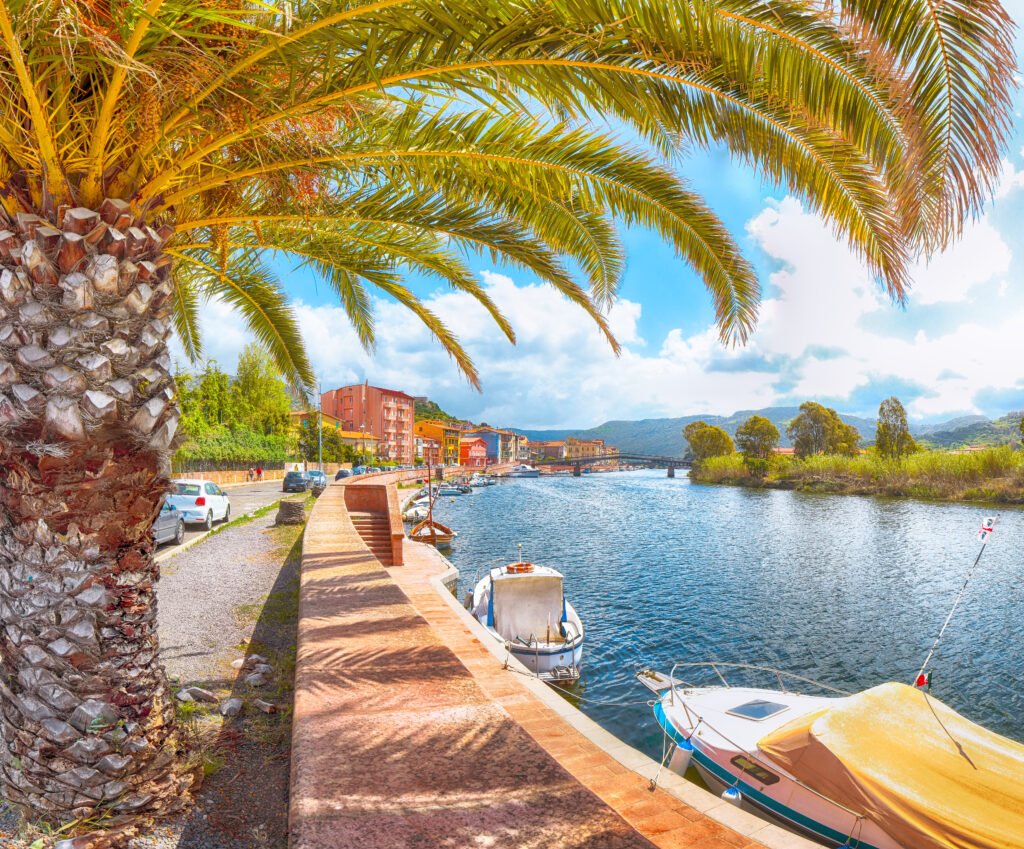

- Head to Oristano, stopping at the Giara di Gesturi to see wild horses.
- Visit the ancient city of Tharros and the beautiful beaches of the Sinis Peninsula.
- Overnight in Oristano.
- Day 4: Oristano to Alghero


- Drive to Alghero, known for its Catalan heritage and charming old town.
- Explore the historic center, visit the Alghero Cathedral, and enjoy the coastal views.
- Overnight in Alghero.
- Day 5: Alghero and Grotte di Nettuno


- Take a boat trip to the Neptune’s Grotto, a stunning marine cave.
- Spend the afternoon at Maria Pia Beach or exploring more of Alghero.
- Overnight in Alghero.
- Day 6: Alghero to Olbia via Costa Smeralda


- Drive to Olbia, passing through the luxurious Costa Smeralda.
- Visit Porto Cervo and enjoy the glamorous beaches like Spiaggia del Principe.
- Overnight in Olbia.
- Day 7: Departure from Olbia


- Depending on your flight time, explore Olbia’s archaeological sites or relax on nearby beaches.
Two-Week Itinerary
- Days 1-7: Follow the One-Week Itinerary
- Day 8: Olbia to La Maddalena Archipelago
- Take a ferry to La Maddalena and explore the archipelago’s stunning beaches and clear waters.
- Overnight on La Maddalena.
- Day 9: La Maddalena


- Spend the day island hopping and snorkeling around La Maddalena and Caprera.
- Overnight on La Maddalena.
- Day 10: La Maddalena to Santa Teresa di Gallura
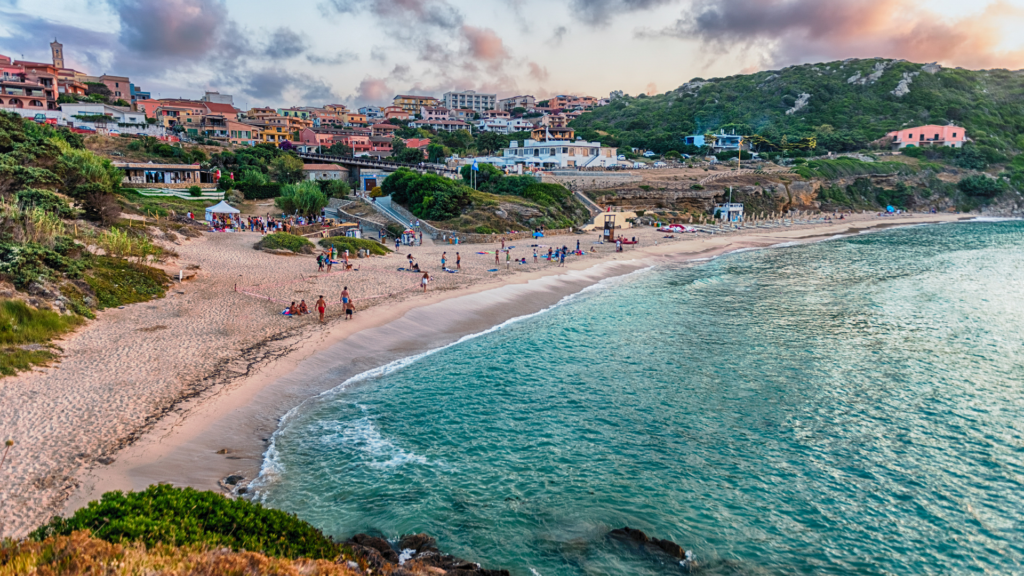

- Ferry back to the mainland and drive to Santa Teresa di Gallura.
- Visit the beautiful Rena Bianca Beach and the historic Longonsardo Tower.
- Overnight in Santa Teresa di Gallura.
- Day 11: Santa Teresa di Gallura to Castelsardo


- Drive to Castelsardo, a picturesque medieval town.
- Explore the castle, old town, and local handicraft shops.
- Overnight in Castelsardo.
- Day 12: Castelsardo to Nuoro


- Head inland to Nuoro, the cultural heart of Sardinia.
- Visit the Museo del Costume and the birthplace of writer Grazia Deledda.
- Overnight in Nuoro.
- Day 13: Nuoro to Ogliastra


- Explore the Ogliastra region, known for its rugged landscapes and traditional villages.
- Visit Cala Goloritzé and hike in the Supramonte mountains.
- Overnight in Ogliastra.
- Day 14: Ogliastra to Cagliari


- Return to Cagliari for your final night.
- Enjoy a farewell dinner and explore any remaining sights in the city.
Popular Day Trips from Major Cities
From Cagliari:


- Barumini: Visit the UNESCO World Heritage site of Su Nuraxi, an ancient Nuragic complex.
- Pula and Nora: Explore the archaeological ruins of the ancient city of Nora and relax on the nearby beaches.
- Villasimius: Spend a day on the stunning beaches and enjoy water activities like snorkeling and kayaking.
From Alghero:


- Neptune’s Grotto: Take a boat trip to this impressive marine cave located at Capo Caccia.
- Bosa: Drive along the scenic coastal road to the colorful town of Bosa, known for its castle and charming streets.
- Stintino and La Pelosa Beach: Visit one of the most beautiful beaches in Sardinia with its shallow, crystal-clear waters.
From Olbia:


- Costa Smeralda: Explore the luxurious beaches and towns like Porto Cervo and Porto Rotondo.
- La Maddalena Archipelago: Take a ferry to La Maddalena and spend the day island hopping.
- San Pantaleo: Visit this quaint village known for its artist community and weekly market.
Combining Beach Relaxation with Cultural Exploration
- Cagliari and Surroundings:
- Spend your mornings exploring historical sites like the Bastione di Saint Remy and the Roman Amphitheatre.
- Relax in the afternoons at Poetto Beach or take a short drive to the beaches of Chia and Tuerredda.
- Alghero and Coastal Areas:
- Explore the medieval old town and visit the Alghero Aquarium in the morning.
- Spend the afternoon at Maria Pia Beach or take a boat trip to Neptune’s Grotto.
- Oristano and Sinis Peninsula:
- Start your day with a visit to the ancient city of Tharros and the nearby archaeological museum.
- Enjoy the afternoon on the beautiful beaches of the Sinis Peninsula, like Is Arutas with its quartz sand.



